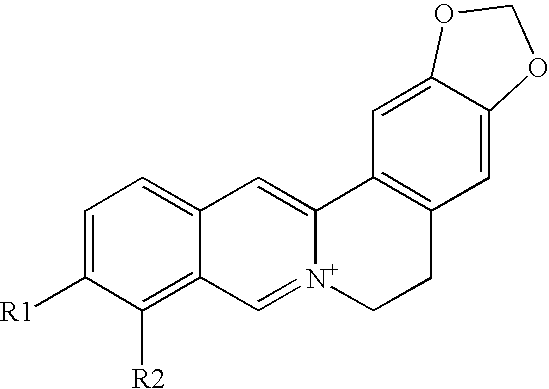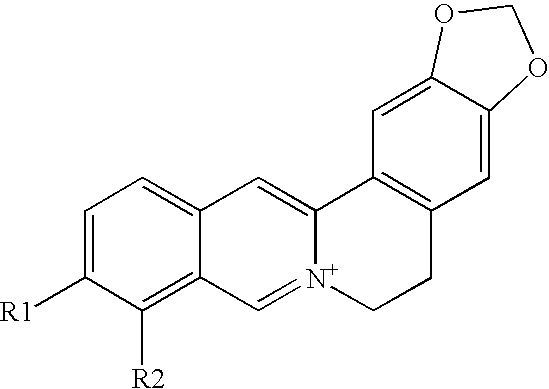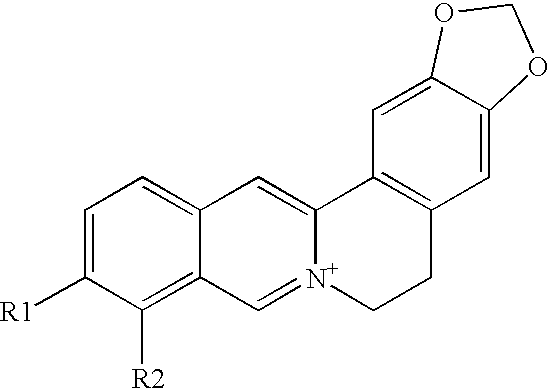Composition for the protection and regeneration of nerve cells containing berberine derivatives
a technology of berberine derivatives and nerve cells, which is applied in the direction of heterocyclic compound active ingredients, biocide, food preparation, etc., can solve the problems of synaptic denaturation, synaptic detachment, and difficult regeneration of nerve cells, so as to improve the energy metabolism of nerve cells, improve the activity of cholinergic signal transmission system, and accelerate the degeneration
- Summary
- Abstract
- Description
- Claims
- Application Information
AI Technical Summary
Benefits of technology
Problems solved by technology
Method used
Image
Examples
example 1
General Methods
1) Berberine Chloride (Product #: B3251, Sigma-Aldrich, U.S.A) was Used
2) Nerve Cell Line Culture
[0096] Since HiB5 cells derived from white rat embryonic hippocampus were prepared by retroviral infection of temperature sensitive SV40 large T antigen, they divided at 34.degree. C., but the cell division stopped at 39.degree. C. (body temperature of rat). When bFGF (20 ng / ml) was added to the HiB5 cells, cell survival increased and HiB5 cells differentiated into nerve cells to express marker molecules of nerve cells. Cell culture medium was prepared by adding a mixture of 10% FBS (fetal bovine serum), penicillin / streptomycin, glutamine and sodium pyruvate (0.11 g / L) to DMEM. On differentiating at 39.degree. C., another cell culture medium was prepared by adding pyruvate to a serum-free medium (N2, containing DMEM / F12, insulin, transferrin, Putreseine and BSA; Botten Stein & Sato., 1979). PC12 cells and SH-SY5Y cells were cultured in DMEM supplemented with 10% FBS. In or...
example 2
Regenerative and Protective Effects of Berberine on Cranial Nerve Cells Using MK-801 Model
1) Model for Apoptosis Induced by MK-801
[0101] MK-801 reaches maximal concentrations in plasma and brain within 10 to 30 minutes of injection with an elimination half-life of 1.9 hours (Vezzani, A., Serafini, R., Stasi, M. A., Caccia, S., Conti, I., Tridico, R. V. and Samanin, R. (1989) Kinetics of MK-801 and its effect on quinolinic acid-induced seizures and neurotoxicity in rats. J Pharmacol Exp Ther 249, 278-83). Ikonomidou et al. found that when MK-801 was administered to a young rat (7-8-days old) to inhibit NMDA receptors (for 2-3 hours), nerve cells highly sensitive to NMDA receptors died through apoptotic neurodegeneration. At this time, the number of dead nerve cells amounted to 12-26% of total nerve cells (Ikonomidou, C., Bosch, F., Miksa, M., Bittigau, P., Vockler, J., Dikranian, K., Tenkova, T. I., Stefovska, V., Turski, L. and Olney, J. W. (1999) Blockade of NMDA receptors and apop...
example 3
Quantitative Comparison of Nerve Cell Apoptosis in White Rat Cerebra
[0113] A group administered with MK-801 (0.5 mg / kg), a group administered with berberine (5 mg / kg) for 5 days, and a group pretreated with berberine (5 mg / kg) for 5 days and then administered with MK-801 (0.5 mg / kg), were used to quantitatively compare the inhibition of nerve cell apoptosis by berberine. The number of TUNEL-positive dead nerve cells in the same area of cerebral slices of 12 rats per group was counted, and the numbers were averaged (FIG. 1).
PUM
| Property | Measurement | Unit |
|---|---|---|
| Time | aaaaa | aaaaa |
| Time | aaaaa | aaaaa |
| Time | aaaaa | aaaaa |
Abstract
Description
Claims
Application Information
 Login to View More
Login to View More - R&D
- Intellectual Property
- Life Sciences
- Materials
- Tech Scout
- Unparalleled Data Quality
- Higher Quality Content
- 60% Fewer Hallucinations
Browse by: Latest US Patents, China's latest patents, Technical Efficacy Thesaurus, Application Domain, Technology Topic, Popular Technical Reports.
© 2025 PatSnap. All rights reserved.Legal|Privacy policy|Modern Slavery Act Transparency Statement|Sitemap|About US| Contact US: help@patsnap.com



